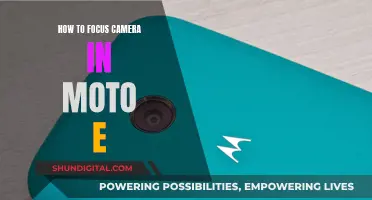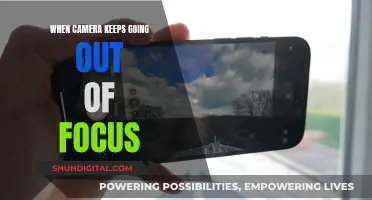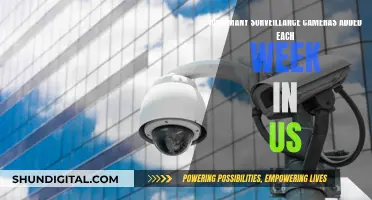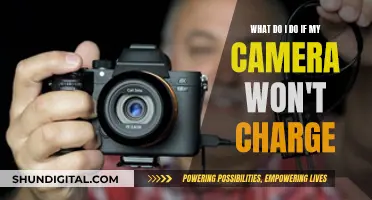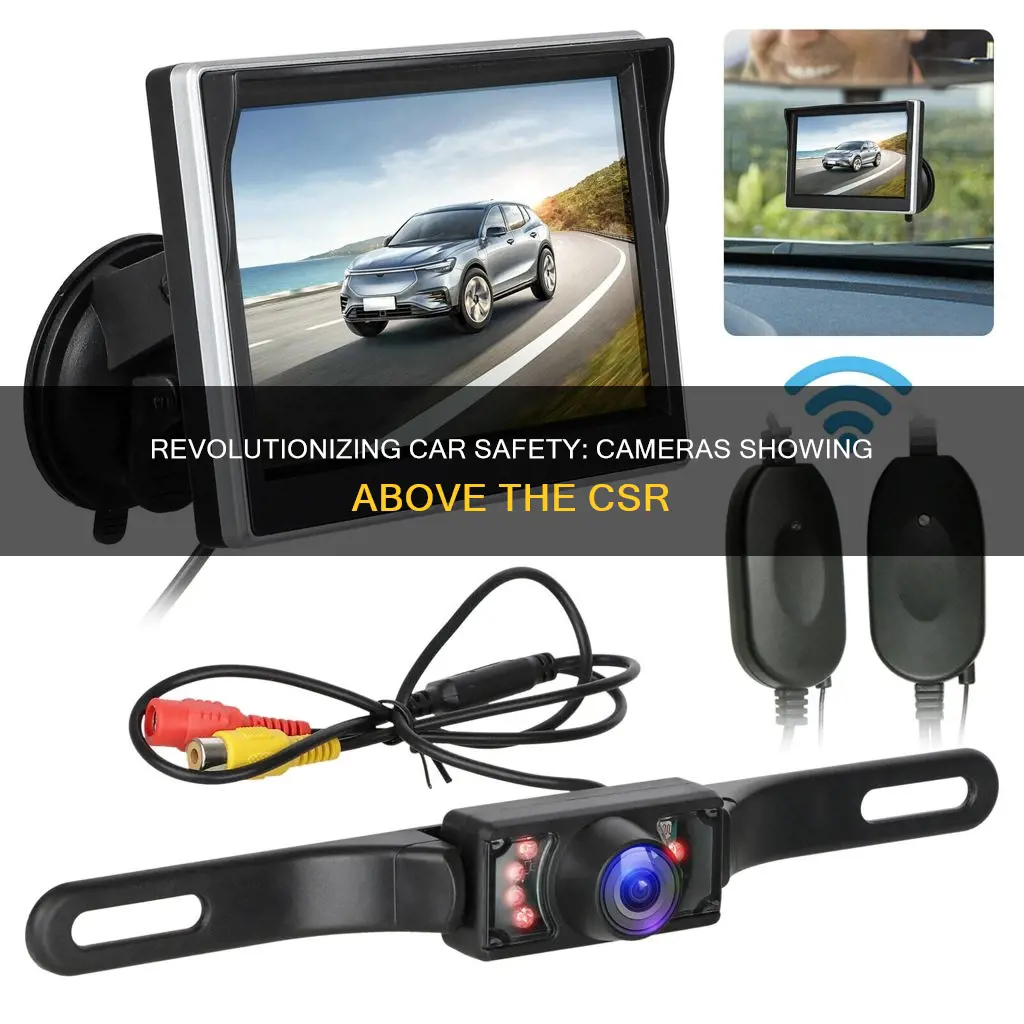
New car cameras can show a bird's-eye view of the vehicle and its surroundings, as if filmed by a drone. This is achieved through a combination of hardware and software that work together to display information related to the vehicle's surroundings on the infotainment screen. This technology is known as a 360-degree view or bird's-eye view camera system and is becoming increasingly popular in new cars. It provides drivers with a real-time view of their surroundings, making it easier to navigate and park, while also improving safety.
| Characteristics | Values |
|---|---|
| Purpose | To improve vehicle security, safety and convenience |
| Data Use | Data is used by manufacturers for future innovations like digital road maps |
| Number of Cameras | Typically 4-6 cameras |
| Camera Locations | Front grille, exterior rear-view mirrors, rear, sides |
| Camera Functionality | Cameras provide a bird's eye view of the vehicle's exterior |
| Display | Video from cameras is projected on the infotainment system screen |
| Feedback | Feedback mechanisms such as audio alerts notify the driver of nearby objects |
| Image Processing | Software stitches together images from multiple cameras to create a composite image |
| Guidelines | Guidelines can be superimposed on the image to show the vehicle's orientation and expected direction of travel |
| Camera Types | Wireless, night vision, built-in audio intercoms, custom cameras |

Camera placement
Number and Positioning of Cameras:
The number of cameras used in a surround-view system can vary, typically ranging from four to six cameras. The standard setup includes one camera positioned at the front, usually in the grille, and two wide-angle cameras placed in the exterior rearview mirror areas. Additionally, a camera is mounted at the rear, often serving as the backup camera. More advanced systems may add side-view cameras positioned ahead of the front wheels, enabling drivers to see what's on the other side of obstacles.
Strategic Placement:
The cameras are strategically placed to capture the entire perimeter of the vehicle without obstructing its aesthetics or functionality. System designers use computer-aided design (CAD) models to simulate and analyze the field of view and blind spots from different angles and vehicle load configurations. This ensures that the cameras have a clear view of the vehicle's surroundings, optimizing the effectiveness of the system.
Camera Calibration:
Proper camera calibration is essential to ensure the optimal performance of the surround-view system. Intrinsic and extrinsic calibration are required because no two cameras produce identical outputs. Factors such as lens placement, aging, and thermal expansion can cause slight differences in images. Calibration compensates for these mismatches, ensuring aligned output images and accurate colours.
Integration with Other Sensors:
Regulatory Compliance:
It is important to consider regulatory requirements when placing cameras on vehicles. In the United States and Canada, backup cameras have been mandated by law since 2018 for all new vehicles. These cameras assist in reducing blind spots and enhancing safety during reversing maneuvers.
In summary, camera placement in modern vehicles with bird's-eye view or surround-view systems involves strategic positioning, calibration, and integration with other sensors. The goal is to provide a comprehensive view of the vehicle's surroundings, improve safety, and enhance the overall driving experience. Careful consideration of camera placement ensures that these systems deliver accurate and reliable visuals to drivers.
Focusing Your Camera on Champions in League of Legends
You may want to see also

Image stitching
Modern cars are increasingly being equipped with advanced driver assistance systems (ADAS) that rely on image stitching to provide a 360-degree or bird's-eye view of the vehicle's surroundings. This technology enhances safety, improves convenience, and aids in parking and navigation.
The video signals from these cameras are fed into an image-processing program, which then knits together the individual inputs to create a synthetic, yet positionally accurate, top-down view. This process involves geometric alignment, photometric alignment, and composite view synthesis. Geometric alignment corrects lens distortion and transforms the perspective, while photometric alignment matches the brightness and colour of individual camera views for a seamless final image. Finally, the composite view synthesis is where the actual stitching of images takes place.
The image stitching process typically includes the following steps:
- Image registration: This involves detecting key points on an image and assigning them to a common ground plane. Custom pattern registration is commonly used in 360-degree vision systems.
- Warping: In this step, the undistorted image is deformed to match certain defined key points. Techniques such as homography, polynomial deformation, or moving least squares are applied.
- Blending: This is where individual images are blended and merged to obtain the final stitched image. Multiband blending, feathering, and 50% blending are commonly used algorithms for this step.
The result is a seamless, top-down view of the vehicle and its surroundings, projected onto the dashboard or infotainment system. This technology not only enhances the driver's situational awareness but also assists in parking, manoeuvring, and navigating tight spaces.
How License Plate Readers Are Catching Speedsters
You may want to see also

Data science
The bird's eye view camera system, also known as the 360-degree camera system, is an advanced driver assistance technology that provides drivers with a real-time view of their vehicle's surroundings. This system is a collection of devices that work together to offer a top-down view, as if the car was being filmed by a drone, and is especially useful for parking and manoeuvring in tight spaces. This technology is a result of data science and image processing techniques, and is becoming an increasingly popular feature in new cars.
Components of the System
The bird's eye view camera system is a combination of hardware and software components that work together to display information related to the vehicle's surroundings on an infotainment screen. The system typically consists of:
- Surround View Cameras: Four to six wide-angle cameras are integrated into the body panel of the vehicle, usually placed on the front grille, under the rear-view mirrors, and at the rear. These cameras capture images of the entire perimeter of the vehicle.
- Proximity Sensors: Ultrasonic or electromagnetic sensors that aid in evaluating the distance of nearby objects. These sensors send signals and measure the time taken for the signals to reflect back, indicating the actual distance to the object.
- Image Processing Software: The data from the cameras is sent to an image processing module, where individual images are stitched together to produce a cohesive, real-time view of the car and its surroundings. This process involves geometric and photometric alignment, and composite view synthesis, to create a seamless top-down image.
- Display Hardware: The processed video is then projected onto an infotainment system screen, providing a visual representation of the vehicle's surroundings. Audio alerts are also used to notify the driver of nearby objects.
The bird's eye view camera system relies on data science and image processing techniques to create a coherent composite image. Here are some of the key techniques used:
- Image Registration: This process involves detecting key points on an image and assigning them to a common ground plane. Custom pattern registration is commonly used in 360-degree vision systems.
- Warping: The undistorted image is deformed to match defined key points using techniques like homography, polynomial deformation, or moving least squares.
- Blending: The individual images are blended and merged to obtain the final stitched image. Algorithms such as multiband blending, feathering, and 50% blending are commonly used.
- Geometric and Photometric Alignment: The geometric alignment process includes lens distortion correction and perspective transformation. Photometric alignment ensures that the brightness and colour of individual camera views match, creating a consistent final image.
Benefits and Applications
The bird's eye view camera system offers several advantages and has various applications:
- Enhanced Parking and Manoeuvring: The system provides a bird's eye view of the vehicle and its surroundings, making it easier for drivers to navigate into parking spots and avoid obstacles.
- Safety: By providing a 360-degree view, the system improves safety by reducing blind spots and helping drivers detect nearby objects, pedestrians, and potential hazards.
- Autonomous Vehicles: The data collected by these camera systems can contribute to the development of autonomous vehicles. The cameras can capture details about driving habits and surroundings, aiding in creating digital road maps for autonomous driving.
- Reducing Risky Behaviour: Camera systems can be used to monitor driver behaviour and help combat issues like drunk driving or distracted driving.
- Data for Innovation: Automakers can use the data collected by the cameras for future innovations and improvements in vehicle safety and performance.
In conclusion, the bird's eye view camera system in modern cars is a result of advancements in data science and image processing techniques. By combining multiple camera inputs and using sophisticated algorithms, the system provides drivers with a comprehensive view of their vehicle's surroundings, enhancing safety and manoeuvrability. This technology is becoming increasingly popular and is expected to play a crucial role in the future of autonomous vehicles.
Transferring Movies from iPad Camera to Your Computer
You may want to see also

Safety and security
The safety and security benefits of 360-degree cameras in cars are significant. Firstly, they eliminate blind spots, providing drivers with a comprehensive view of their surroundings, which is particularly useful when navigating tight spaces. This technology is a godsend when it comes to parallel parking, as it allows drivers to see obstacles that would otherwise be hidden, reducing the risk of collisions.
Additionally, 360-degree cameras can improve road safety by helping to avoid accidents with pedestrians and cyclists. The cameras provide a clear view of the area behind the vehicle, which is often a blind spot for drivers. This feature is especially important when reversing, as it helps to prevent backover crashes, which have caused numerous fatalities and injuries in the past.
The use of multiple cameras and image-processing software in these systems offers a seamless, top-down view of the vehicle and its surroundings. This technology, also known as a bird's-eye view or surround view, is now offered by almost every major automaker, enhancing both safety and convenience for drivers.
Furthermore, 360-degree cameras can aid in reducing risky behaviour. For example, Volvo has announced plans to install in-cabin cameras in all of its vehicles to monitor driver behaviour and enable the car to intervene in cases of intoxication or distraction. This technology has the potential to save lives by preventing drunk driving and reducing distractions while driving.
While 360-degree cameras are typically found in higher-end vehicles due to their cost, they are becoming increasingly popular as a safety feature. They provide invaluable assistance when manoeuvring large vehicles or driving off-road, where visibility is often limited.
Gardepro Cameras: Where Are They Manufactured?
You may want to see also

Self-driving cars
LiDAR
Proponents of LiDAR include Waymo, Cruise, Uber and Velodyne. LiDAR uses pulses of light to detect objects, in a similar way to radar, which uses radio waves. These pulses can determine the distance and range of an object, providing valuable data to self-driving cars. LiDAR can also create a visual map of its surroundings and has been proven to be effective in measuring distance. It is used in coordination with cameras in self-driving cars and can provide a 360-degree view to help the car drive in any type of condition.
Cameras
Tesla has been the least supportive of LiDAR, instead favouring camera systems. Cameras provide images which are then analysed by software using AI. The cameras on Tesla models are used by its Autopilot self-driving feature to provide a 360-degree view of its surroundings. Cameras can also read text from road signs, which is important in case of detours and roadworks. Cameras on Tesla cars use optics combined with computer vision that provides computational imaging that continuously analyses the images on the camera.
The Verdict
Cameras are hailed by Elon Musk as the most reliable type of vision system. They have a better advantage at visual recognition and are relatively cheap compared to radar and LiDAR. However, they don't perform well in different weather or lighting conditions and they require a lot of processing for extracting information.
LiDAR is more expensive and requires more space in cars, but it can see objects even in hazardous weather conditions. However, it is affected by wavelength stability and detector sensitivity, and it requires more data processing to create images and identify objects.
The answer to which technology is best may lie in a combination of the two. Sensor fusion, incorporating the best elements of LiDAR and camera systems, could offer a lot in terms of public safety.
Olympus Pen Camera Battery: Charging Time Explained
You may want to see also
Frequently asked questions
The 360-degree camera technology, also known as Bird's Eye View or Surround View, uses a combination of four to six cameras placed around the vehicle to provide a top-down view of the car and its surroundings. The images from these cameras are stitched together using image-processing software, creating a seamless, composite image that is projected onto the vehicle's display screen. This technology enhances safety and makes parking in confined spaces much easier.
The 360-degree camera system offers several advantages to drivers. Firstly, it provides a bird's-eye view of the vehicle and its surroundings, making it easier to navigate and park, especially in tight spaces. Secondly, it includes a split-view screen that displays both the rearview and the surround-view images, which is extremely useful when parallel parking. Additionally, the system offers proximity alerts, notifying drivers of nearby objects that may be out of their direct line of sight. This technology is also valuable for larger vehicles and off-road driving, as it provides a clear view of obstacles and helps with manoeuvring.
Many automakers now offer 360-degree camera technology in at least one of their models. Some examples include Toyota, Nissan, Hyundai, Mitsubishi, Mercedes-Benz, Lincoln, Genesis, BMW, Tesla, and Kia. However, this technology often comes as an optional extra or is included in higher trim levels, so it may increase the overall cost of the vehicle.


